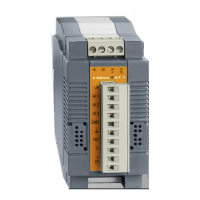e.bloxx A6-2CF
MOUNTING E.BLOXX AND CONNECTING WIRES
HB_EBLOXX-A62CF_E_V19.doc
19
Gantner Instruments Test & Measurement GmbH
3.5. Shielding
In case of increased interference, such as in industrial areas, we recommend shielding of bus and signal cables. In
general, the shield should be connected to the protective grounding (not DataGround!) at each bus connection. If
necessary, the shield should also be applied along the course of the cable several times. For shorter distances, e.g. with
stub cables, the interference response is often improved if the shielding is only applied to the stub cable exit.
Bus users such as controllers (PLCs), computers (PCs), repeaters and interface converters (ISK), etc., generally feature
the possibility of applying the shield directly to the appliance or to separate shield rails. Shield rails offer the advantage
of preventing possible interfering signals from reaching the appliance. The shields, which are connected to protective
grounding, conduct interference signals off before reaching the module.
The e.bloxx A6-2CF do not have a direct shield connection at the module. Here the shield of the bus cable can be
connected to earth e.g. by so-called shield clamps.
Picture 3.10
. - Grounding of the Bus Line Shield at an e.bloxx A6-2CF
Notice:
The shielding screen must not be connected to the ground (GND, 0V) of the power supply and it should
always be connected to earth with a large surface and low-inductance.
3.6. Rapid Bus Link Plug
The e.bloxx A6-2CF have plugs on the left and right side which allow to connect the bus and power supply from one
module to the next with a Rapid Bus Link Plug (type designation: ICM 100). This kind of connecting bus and power
supply is particularly advantageous if several modules are mounted on one common profile rail side by side. In this
case, only the terminal of one module has to be connected. Furthermore, various modules of the e.bloxx series may be
connected with the Rapid Bus Link Plug.

